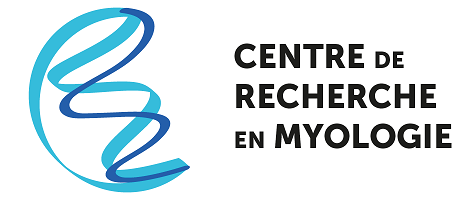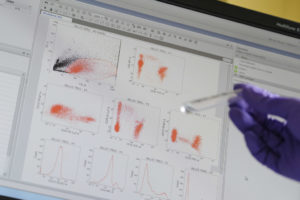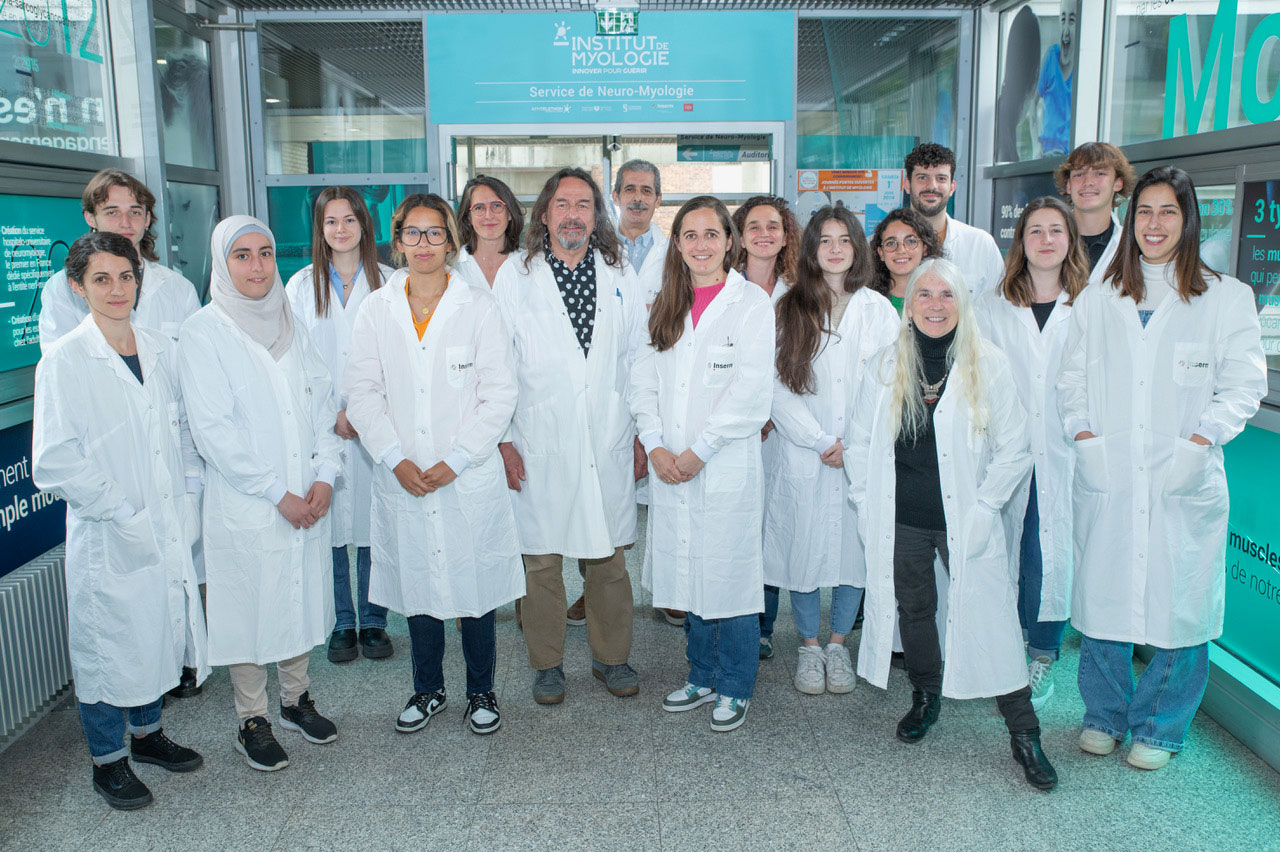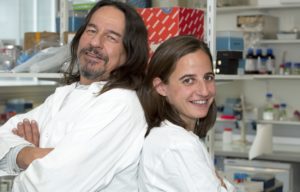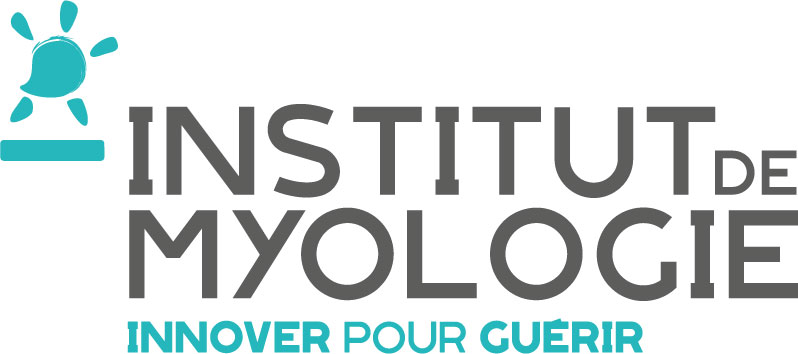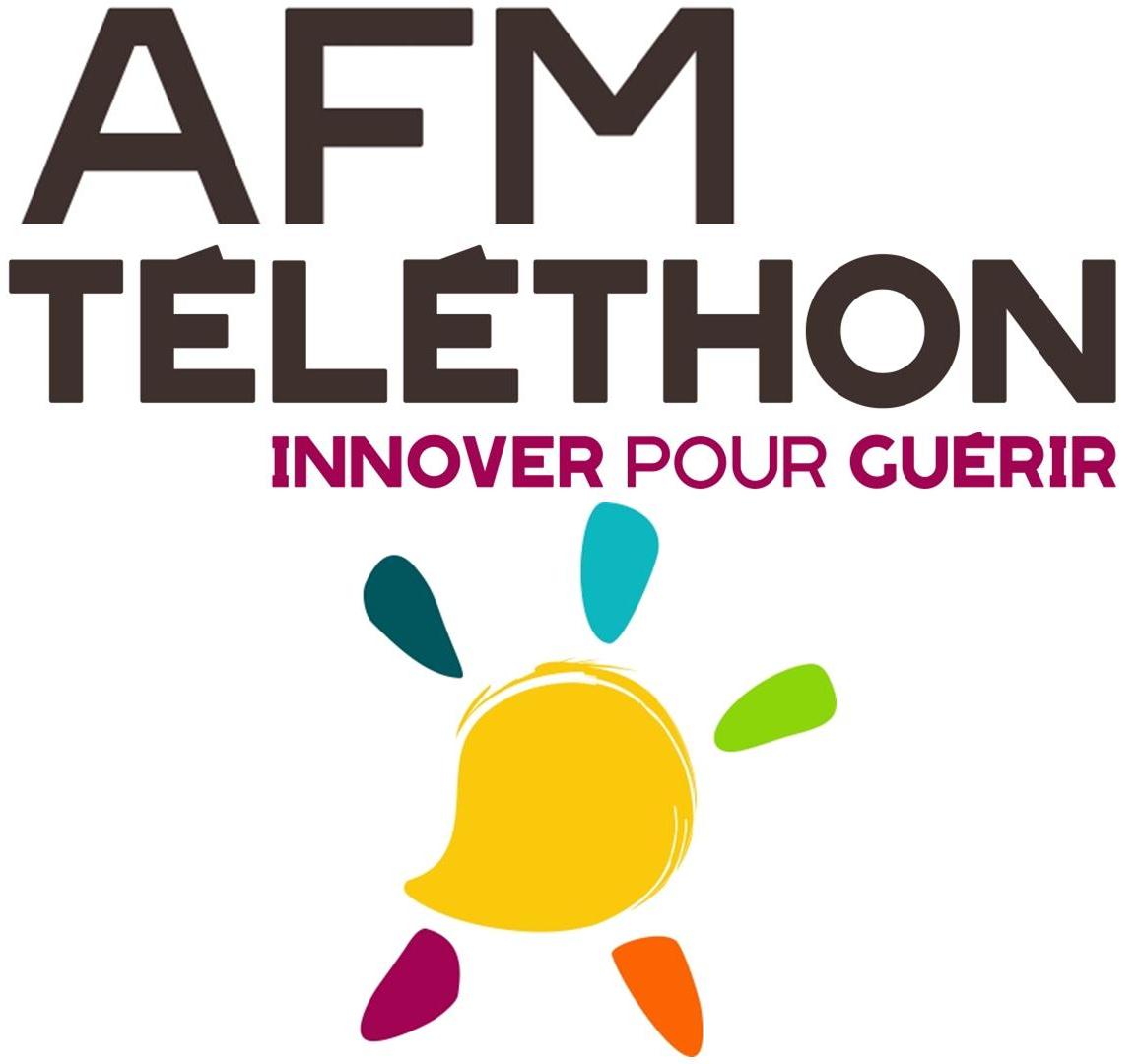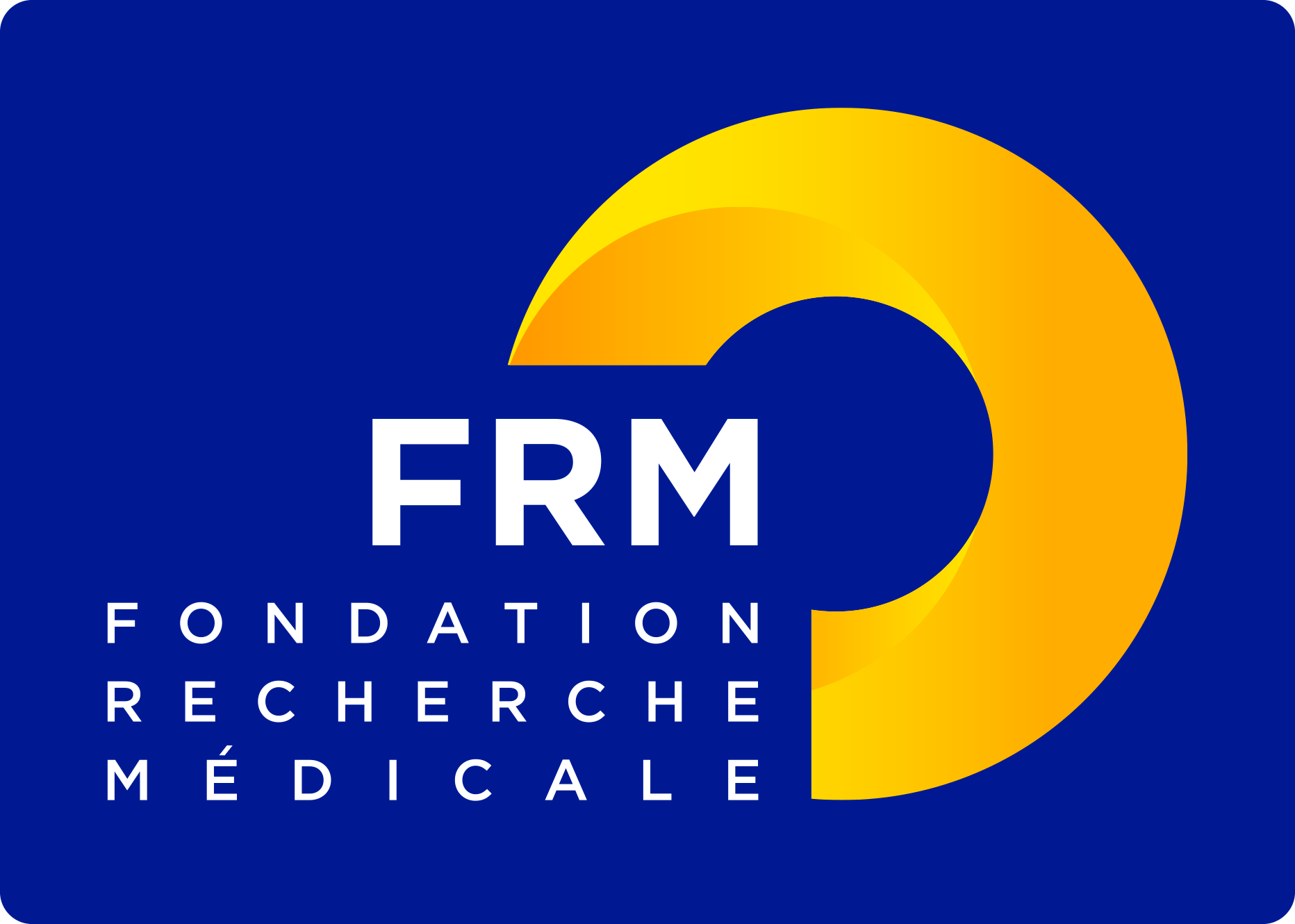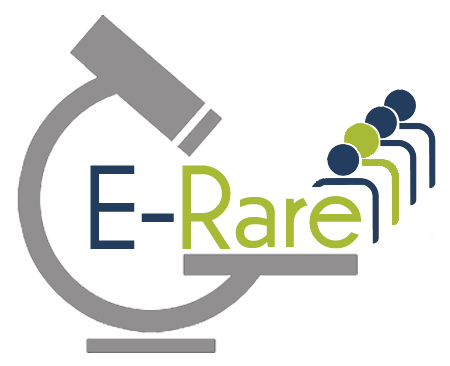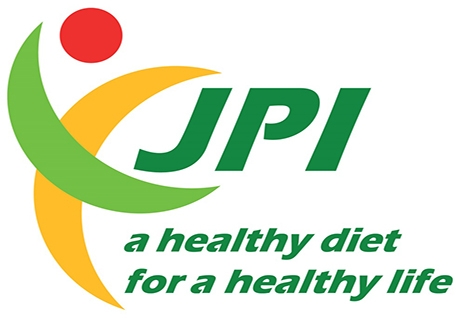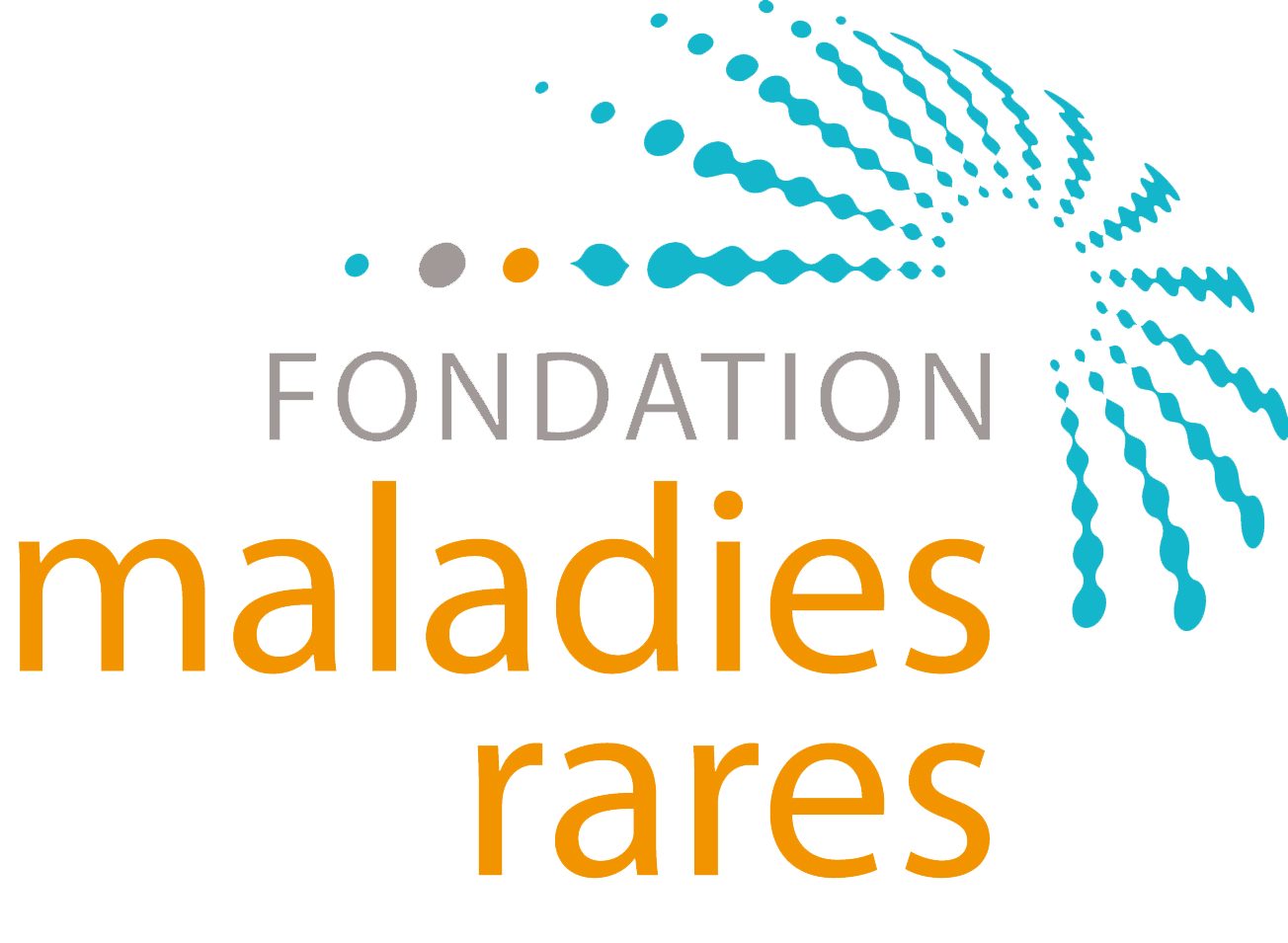Cellular and molecular orchestration in muscle regeneration, during ageing and in pathologies.
The team focuses on molecular and cellular actors involved in human in skeletal muscle regeneration, during ageing and in muscle dystrophies, particularly oculo-pharyngeal muscular dystrophy (OPMD) and Duchenne muscular dystrophy (DMD). Our approaches aim at better understandng RNA metabolism, muscle regeneration, muscle stem cells and fibrosis, in order to develop therapeutic strategies.The team has developed a solid expertise on cellular models (incuding through the MyoLine platform for immortalization taht we have set up) and on xenotransplantation using several immunodeficient mouse models and different types of grafts.
Research projects currently developed in parralel and in synergy within the team :
- Molecular mechanisms involved in OPMD and in muscle ageing
- Cell-to-cell communication during muscle regeneration, muscle ageing and fibrosis
- Development of therapeutic strategies
International associated laboratory (LIA) between France and Brazil:
Another aspect specific to our team is the development of international collaborations. In addition to numerous collaborations established over many years, we have set up an international associated laboratory between INSERM and Sorbonne University on the French side, and FIOCRUZ and the Federal University of Rio-de-Janeiro for the brazilian side. This LIA aims at synergize expertises on skeletal muscle and neuromuscular diseases from the French team and on inflammation from the Brazilian team. This LIA has been renew already once, and has produced 14 common publications, a common patent, long-term exchanges of 3 post-docs, 5 common PhD and many short term exchanges, including invited professors in both countries. A common teaching project is being set up (master and/or PhD), which will focus on innovative biotherapies for skeletal muscle.
| Name | Position | ORCID |
|---|
Journal articles
- C. Trollet, A. Marhic, F. Fer, M. Brechenmacher, E. Negroni, et al.. 84PAutologous myoblast transplantation combined with cricopharyngeal myotomy for oculopharyngeal muscular dystrophy: long-term results of 24 patients and comparison with cricopharyngeal myotomy alone. Neuromuscular Disorders, 2025, 53, pp.105865. ⟨10.1016/j.nmd.2025.105865⟩. ⟨hal-05306581⟩
- Baptiste Bogard, Hélène Bonnet, Ekaterina Boyarchuk, Gilles Tellier, Denis Furling, et al.. Small nucleolar RNAs promote the restoration of muscle differentiation defects in cells from myotonic dystrophy type 1. Nucleic Acids Research, 2025, 53 (6), pp.gkaf232. ⟨10.1093/nar/gkaf232⟩. ⟨hal-05382401⟩
- Léna d'Agata, Phoebe Rassinoux, Céline Gounou, Flora Bouvet, Dounia Bouragba, et al.. A Novel Assay Reveals the Early Setting‐Up of Membrane Repair Machinery in Human Skeletal Muscle Cells. Journal of Cellular Biochemistry, 2024, 126 (1), pp.e30662. ⟨10.1002/jcb.30662⟩. ⟨hal-04884353⟩
- Eden Engal, Aveksha Sharma, Uria Aviel, Nadeen Taqatqa, Sarah Juster, et al.. DNMT3B splicing dysregulation mediated by SMCHD1 loss contributes to DUX4 overexpression and FSHD pathogenesis. Science Advances , 2024, 10 (22), pp.eadn7732. ⟨10.1126/sciadv.adn7732⟩. ⟨hal-04603956⟩
- Paul Dowling, Capucine Trollet, Laura Muraine, Elisa Negroni, Dieter Swandulla, et al.. The potential of proteomics for in-depth bioanalytical investigations of satellite cell function in applied myology. Expert Review of Proteomics, 2024, pp.1-7. ⟨10.1080/14789450.2024.2356578⟩. ⟨inserm-04603178⟩
- Judit Núñez-Manchón, Júlia Capó, Alicia Martínez-Piñeiro, Eduard Juanola, Jovan Pesovic, et al.. Immortalized human myotonic dystrophy type 1 muscle cell lines to address patient heterogeneity. iScience, 2024, 27 (6), pp.109930. ⟨10.1016/j.isci.2024.109930⟩. ⟨hal-04603947⟩
- Alice Granados, Maeva Zamperoni, Roberta Rapone, Maryline Moulin, Ekaterina Boyarchuk, et al.. SETDB1 modulates the TGFβ response in Duchenne muscular dystrophy myotubes. Science Advances , 2024, 10 (18), pp.eadj8042. ⟨10.1126/sciadv.adj8042⟩. ⟨hal-04601015⟩
- Paul Dowling, Capucine Trollet, Elisa Negroni, Dieter Swandulla, Kay Ohlendieck. How Can Proteomics Help to Elucidate the Pathophysiological Crosstalk in Muscular Dystrophy and Associated Multi-System Dysfunction?. Proteomes, 2024, 12 (1), pp.4. ⟨10.3390/proteomes12010004⟩. ⟨inserm-04603208⟩
- Julia Pereira Lemos, Liliane Patrícia Gonçalves Tenório, Vincent Mouly, Gillian Butler-Browne, Daniella Arêas Mendes-Da-Cruz, et al.. T cell biology in neuromuscular disorders: a focus on Duchenne Muscular Dystrophy and Amyotrophic Lateral Sclerosis. Frontiers in Immunology, 2023, 14, pp.120283. ⟨10.3389/fimmu.2023.1202834⟩. ⟨hal-04603915⟩
- Barbara Tedesco, Leen Vendredy, Elias Adriaenssens, Marta Cozzi, Bob Asselbergh, et al.. HSPB8 frameshift mutant aggregates weaken chaperone-assisted selective autophagy in neuromyopathies. Autophagy, 2023, 19 (8), pp.2217-2239. ⟨10.1080/15548627.2023.2179780⟩. ⟨hal-04253799⟩
- Willem de Ridder, Geert de Vries, Kristof van Schil, Tine Deconinck, Vincent Mouly, et al.. A homozygous loss of function variant in POPDC3: From invalidating exercise intolerance to a limb-girdle muscular dystrophy phenotype. Neuromuscular Disorders, 2023, 33 (5), pp.432-439. ⟨10.1016/j.nmd.2023.04.003⟩. ⟨hal-04253823⟩
- Eline Lemerle, Jeanne Lainé, Marion Benoist, Gilles Moulay, Anne Bigot, et al.. Caveolae and Bin1 form ring-shaped platforms for T-tubule initiation. eLife, 2023, 12, ⟨10.7554/eLife.84139⟩. ⟨hal-04094370⟩
- Luca Pinton, Moustafa Khedr, Valentina Lionello, Shilpita Sarcar, Sara Maffioletti, et al.. 3D human induced pluripotent stem cell–derived bioengineered skeletal muscles for tissue, disease and therapy modeling. Nature Protocols, 2023, 18 (4), pp.1337-1376. ⟨10.1038/s41596-022-00790-8⟩. ⟨inserm-04603284⟩
- Laura Muraine, Mona Bensalah, Gillian Butler-Browne, Anne Bigot, Capucine Trollet, et al.. Update on anti-fibrotic pharmacotherapies in skeletal muscle disease. Current Opinion in Pharmacology, 2023, 68, pp.102332. ⟨10.1016/j.coph.2022.102332⟩. ⟨hal-04253789⟩
- Alexis Boulinguiez, Fany Roth, Hadidja Rose Mouigni, Gillian Butler-Browne, Vincent Mouly, et al.. Les agrégats nucléaires dans la dystrophie musculaire oculopharyngée. Médecine/Sciences, 2022, 38, pp.13 - 16. ⟨10.1051/medsci/2022175⟩. ⟨hal-03997379⟩
- Laura Muraine, Mona Bensalah, Gillian Butler-Browne, Anne Bigot, Capucine Trollet, et al.. Update on anti-fibrotic pharmacotherapies in skeletal muscle disease. Current Opinion in Pharmacology, 2022, 68, pp.102332. ⟨10.1016/j.coph.2022.102332⟩. ⟨hal-03997340⟩
- Alexandra Monceau, Dylan Moutachi, Mégane Lemaitre, Luis Garcia, Capucine Trollet, et al.. Dystrophin Restoration after Adeno-Associated Virus U7–Mediated Dmd Exon Skipping Is Modulated by Muscular Exercise in the Severe D2-Mdx Duchenne Muscular Dystrophy Murine Model. American Journal of Pathology, 2022, 192 (11), pp.1604-1618. ⟨10.1016/j.ajpath.2022.07.016⟩. ⟨hal-04308024⟩
- Fanny Roth, Jamila Dhiab, Alexis Boulinguiez, Hadidja-Rose Mouigni, Saskia Lassche, et al.. Assessment of PABPN1 nuclear inclusions on a large cohort of patients and in a human xenograft model of oculopharyngeal muscular dystrophy. Acta Neuropathologica, 2022, ⟨10.1007/s00401-022-02503-7⟩. ⟨hal-03832636⟩
- Alexandrine Mahoudeau, Céline Anquetil, Nozomu Tawara, Hossein Khademian, Damien Amelin, et al.. Myostatin in idiopathic inflammatory myopathies: Serum assessment and disease activity. Neuropathology and Applied Neurobiology, 2022, ⟨10.1111/nan.12849⟩. ⟨hal-03830849⟩
- Elisa Negroni, Maria Kondili, Laura Muraine, Mona Bensalah, Gillian Sandra Butler-Browne, et al.. Muscle fibro-adipogenic progenitors from a single-cell perspective: Focus on their “virtual” secretome. Frontiers in Cell and Developmental Biology, 2022, 10, ⟨10.3389/fcell.2022.952041⟩. ⟨hal-03830589⟩
- Alexandra Monceau, Dylan Moutachi, Mégane Lemaitre, Luis Garcia, Capucine Trollet, et al.. Dystrophin Restoration after Adeno-Associated Virus U7–Mediated Dmd Exon Skipping Is Modulated by Muscular Exercise in the Severe D2-Mdx Duchenne Muscular Dystrophy Murine Model. American Journal of Pathology, 2022, ⟨10.1016/j.ajpath.2022.07.016⟩. ⟨hal-03830848⟩
- Alexis Boulinguiez, Christian Duhem, Alicia Mayeuf-Louchart, Benoit Pourcet, Yasmine Sebti, et al.. NR1D1 controls skeletal muscle calcium homeostasis through myoregulin repression. JCI Insight, 2022, 7 (17), ⟨10.1172/jci.insight.153584⟩. ⟨hal-03828260⟩
- Eunhye Kim, Fang Wu, Danbi Lim, Christopher Zeuthen, Yiming Zhang, et al.. Fibroadipogenic Progenitors Regulate the Basal Proliferation of Satellite Cells and Homeostasis of Pharyngeal Muscles via HGF Secretion. Frontiers in Cell and Developmental Biology, 2022, 10, ⟨10.3389/fcell.2022.875209⟩. ⟨hal-03820132⟩
- Laura Le Gall, William J Duddy, Cecile Martinat, Virginie Mariot, Owen Connolly, et al.. Muscle cells of sporadic amyotrophic lateral sclerosis patients secrete neurotoxic vesicles. Journal of Cachexia, Sarcopenia and Muscle, 2022, 13 (2), pp.1385 - 1402. ⟨10.1002/jcsm.12945⟩. ⟨hal-04767184⟩
- Ingo Riederer, Daniella Arêas Mendes-Da-Cruz, Guilherme Cordenonsi da Fonseca, Mariela Natacha González, Otavio Brustolini, et al.. Zika virus disrupts gene expression in human myoblasts and myotubes: Relationship with susceptibility to infection. PLoS Neglected Tropical Diseases, 2022, 16 (2), pp.e0010166. ⟨10.1371/journal.pntd.0010166⟩. ⟨hal-03832616⟩
- Celine Bruge, Marine Geoffroy, Manon Benabides, Emilie Pellier, Evelyne Gicquel, et al.. Skeletal Muscle Cells Derived from Induced Pluripotent Stem Cells: A Platform for Limb Girdle Muscular Dystrophies. Biomedicines, 2022, 10 (6), pp.1428. ⟨10.3390/biomedicines10061428⟩. ⟨hal-03858917⟩
- M Bensalah, L Muraine, A Boulinguiez, Lorenzo Giordani, V Albert, et al.. A negative feedback loop between fibroadipogenic progenitors and muscle fibres involving endothelin promotes human muscle fibrosis.. Journal of Cachexia, Sarcopenia and Muscle, In press, ⟨10.1002/jcsm.12974⟩. ⟨hal-03618341⟩
- Francesco Galli, Vincent Mouly, Gillian Butler-Browne, Giulio Cossu. Challenges in cell transplantation for muscular dystrophy. Experimental Cell Research, 2021, 409 (1), pp.112908. ⟨10.1016/j.yexcr.2021.112908⟩. ⟨hal-03832578⟩
- Dorian Culié, Alexandra Rousseau, Jean-Luc Pretet, Jean Lacau Saint Guily. HPV status and therapeutic initial strategy impact on survival and oncologic outcomes: 5-year results from the multicentric prospective cohort of oropharyngeal cancers Papillophar. European Archives of Oto-Rhino-Laryngology, 2021, 279 (6), pp.3071-3078. ⟨10.1007/s00405-021-07117-5⟩. ⟨hal-04602302⟩
- Xavier Suárez‐calvet, Esther Fernández‐simón, Patricia Piñol‐jurado, Jorge Alonso‐pérez, Ana Carrasco‐rozas, et al.. Isolation of human fibroadipogenic progenitors and satellite cells from frozen muscle biopsies. FASEB Journal, 2021, 35 (9), ⟨10.1096/fj.202100588r⟩. ⟨hal-03350045⟩
- Olivier Boyer, Gillian Butler-Browne, Hector Chinoy, Giulio Cossu, Francesco Galli, et al.. Myogenic Cell Transplantation in Genetic and Acquired Diseases of Skeletal Muscle. Frontiers in Genetics, 2021, 12 (1), pp.23-32. ⟨10.3389/fgene.2021.702547⟩. ⟨hal-05165883⟩
- Marco Narici, Jamie Mcphee, Maria Conte, Martino V Franchi, Kyle Mitchell, et al.. Age‐related alterations in muscle architecture are a signature of sarcopenia: the ultrasound sarcopenia index. Journal of Cachexia, Sarcopenia and Muscle, 2021, ⟨10.1002/jcsm.12720⟩. ⟨hal-03256174⟩
- Vanessa Strings-Ufombah, Alberto Malerba, Shih-Chu Kao, Sonal Harbaran, Fanny Roth, et al.. BB-301: a silence and replace AAV-based vector for the treatment of oculopharyngeal muscular dystrophy. Molecular Therapy - Nucleic Acids, 2021, 24, pp.67 - 78. ⟨10.1016/j.omtn.2021.02.017⟩. ⟨hal-03176223⟩
- Capucine Trollet, Arthur J Cheng, Lykke Sylow, Miguel L Batista, Nicolas J Pillon. Editorial: Skeletal Muscle Immunometabolism. Frontiers in Physiology, 2021, 12, ⟨10.3389/fphys.2021.683088⟩. ⟨hal-03229646⟩
- Jasdeep Saini, Alessandro Faroni, Adam J Reid, Vincent Mouly, Gillian Butler-Browne, et al.. Cross‐talk between motor neurons and myotubes via endogenously secreted neural and muscular growth factors. Physiological Reports, 2021, 9 (8), pp.e14791. ⟨10.14814/phy2.14791⟩. ⟨hal-03215215⟩
- Aline Bamia, Maha Sinane, Rima Naït-Saïdi, Jamila Dhiab, Marc Keruzoré, et al.. Anti-prion Drugs Targeting the Protein Folding Activity of the Ribosome Reduce PABPN1 Aggregation. Neurotherapeutics, 2021, 18 (2), pp.1137-1150. ⟨10.1007/s13311-020-00992-6⟩. ⟨hal-03158577⟩
- Olivier Boyer, Gillian Butler-Browne, Hector Chinoy, Giulio Cossu, Francesco Galli, et al.. Myogenic Cell Transplantation in Genetic and Acquired Diseases of Skeletal Muscle. Frontiers in Genetics, 2021, 12, pp.702547. ⟨10.3389/fgene.2021.702547⟩. ⟨hal-03345371⟩
- Daniel J Owens, Julien Messéant, Sophie Moog, Mark Viggars, Arnaud Ferry, et al.. Lamin-Related Congenital Muscular Dystrophy Alters Mechanical Signaling and Skeletal Muscle Growth. International Journal of Molecular Sciences, 2020, 22 (1), pp.306. ⟨10.3390/ijms22010306⟩. ⟨hal-03146374⟩
- Cara A. Timpani, Kamel Mamchaoui, Gillian Butler-Browne, Emma Rybalka. Nitric oxide (NO) and Duchenne Muscular Dystrophy: NO way to go?. Antioxidants , 2020, 9 (12), pp.1268. ⟨10.3390/antiox9121268⟩. ⟨hal-03276089⟩
- Apostolos Malatras, Ioannis Michalopoulos, Stéphanie Duguez, Gillian Butler-Browne, Simone Spuler, et al.. MyoMiner: explore gene co-expression in normal and pathological muscle. BMC Medical Genomics, 2020, 13 (1), pp.67. ⟨10.1186/s12920-020-0712-3⟩. ⟨hal-02746400⟩
- Jasdeep Saini, Alessandro Faroni, Adam J Reid, Kamel Mamchaoui, Vincent Mouly, et al.. A Novel Bioengineered Functional Motor Unit Platform to Study Neuromuscular Interaction. Journal of Clinical Medicine, 2020, 9 (10), pp.3238. ⟨10.3390/jcm9103238⟩. ⟨hal-03018813⟩
- Adriana C. Bonomo, Fernanda Pinto-Mariz, Ingo Riederer, Claudia F. Benjamim, Gillian Butler-Browne, et al.. Crosstalk Between Innate and T Cell Adaptive Immunity With(in) the Muscle. Frontiers in Physiology, 2020, 11, pp.573347. ⟨10.3389/fphys.2020.573347⟩. ⟨hal-02978746⟩
- Laura Le Gall, Zamalou Gisele Ouandaogo, Ekene Anakor, Owen Connolly, Gillian Butler Browne, et al.. Optimized method for extraction of exosomes from human primary muscle cells. Skeletal Muscle, 2020, 10 (1), ⟨10.1186/s13395-020-00238-1⟩. ⟨hal-03276085⟩
- Maud Wurmser, Nathalie Chaverot, Rouba Madani, Hiroshi Sakai, Elisa Negroni, et al.. SIX1 and SIX4 homeoproteins regulate PAX7+ progenitor cell properties during fetal epaxial myogenesis. Development (Cambridge, England), 2020, pp.dev.185975. ⟨10.1242/dev.185975⟩. ⟨hal-02905565⟩
- Claudia Filippone, Vincent Legros, Patricia Jeannin, Valérie Choumet, Gillian Butler-Browne, et al.. Arboviruses and Muscle Disorders: From Disease to Cell Biology. Viruses, 2020, 12 (6), pp.E616. ⟨10.3390/v12060616⟩. ⟨hal-02905586⟩
- Daniel J Owens, Martina Fischer, Saline Jabre, Sophie Moog, Kamel Mamchaoui, et al.. Lamin Mutations Cause Increased YAP Nuclear Entry in Muscle Stem Cells. Cells, 2020, 9 (4), pp.E816. ⟨10.3390/cells9040816⟩. ⟨inserm-02538651⟩
- Cara A Timpani, Craig A Goodman, Christos G Stathis, Jason D White, Kamel Mamchaoui, et al.. Adenylosuccinic acid therapy ameliorates murine Duchenne Muscular Dystrophy. Scientific Reports, 2020, 10 (1), pp.1125. ⟨10.1038/s41598-020-57610-w⟩. ⟨inserm-02486207⟩
- Stéphane M Camus, Marine Camus, Carmen Figueras-Novoa, Gaelle Boncompain, L. Amanda Sadacca, et al.. CHC22 clathrin mediates traffic from early secretory compartments for human GLUT4 pathway biogenesis. Journal of Cell Biology, 2020, 219 (1), ⟨10.1083/jcb.201812135⟩. ⟨hal-02555498⟩
- Vincent Legros, Patricia Jeannin, Julien Burlaud-Gaillard, Thibault Chaze, Quentin Giai Gianetto, et al.. Differentiation-dependent susceptibility of human muscle cells to Zika virus infection. PLoS Neglected Tropical Diseases, 2020, 14 (8), pp.e0008282. ⟨10.1371/journal.pntd.0008282⟩. ⟨hal-03184236⟩
- Laura Muraine, Mona Bensalah, Jamila Dhiab, Gonzalo Cordova, Ludovic Arandel, et al.. Transduction Efficiency of Adeno-Associated Virus Serotypes After Local Injection in Mouse and Human Skeletal Muscle. Human Gene Therapy, In press, ⟨10.1089/hum.2019.173⟩. ⟨hal-02472542⟩
- Ximena Baez-Matus, Cindel Figueroa-Cares, Arlek Gonzalez-Jamett, Hugo Almarza-Salazar, Christian Arriagada, et al.. Defects in G-Actin Incorporation into Filaments in Myoblasts Derived from Dysferlinopathy Patients Are Restored by Dysferlin C2 Domains. International Journal of Molecular Sciences, 2020, 21 (1), pp.37. ⟨10.3390/ijms21010037⟩. ⟨hal-02512306⟩
- Alberto Malerba, Pierre Klein, Ngoc Lu-Nguyen, Ornella Cappellari, Vanessa Strings-Ufombah, et al.. Established PABPN1 intranuclear inclusions in OPMD muscle can be efficiently reversed by AAV-mediated knockdown and replacement of mutant expanded PABPN1. Human Molecular Genetics, 2019, 28 (19), pp.3301-3308. ⟨10.1093/hmg/ddz167⟩. ⟨hal-02466975⟩
- Jessica Vargas, Frida Loria, Yuan‐ju Wu, Gonzalo Córdova, Takashi Nonaka, et al.. The Wnt/Ca 2+ pathway is involved in interneuronal communication mediated by tunneling nanotubes. EMBO Journal, 2019, 38 (23), ⟨10.15252/embj.2018101230⟩. ⟨hal-02466969⟩
- Pradeep Harish, Alberto Malerba, Ngoc Lu‐nguyen, Leysa Forrest, Ornella Cappellari, et al.. Inhibition of myostatin improves muscle atrophy in oculopharyngeal muscular dystrophy (OPMD). Journal of Cachexia, Sarcopenia and Muscle, 2019, 10 (5), pp.1016-1026. ⟨10.1002/jcsm.12438⟩. ⟨hal-02466979⟩
- Alberto Malerba, Fanny N Roth, Pradeep Harish, Jamila Dhiab, Ngoc Lu-Nguyen, et al.. Pharmacological modulation of the ER stress response ameliorates oculopharyngeal muscular dystrophy. Human Molecular Genetics, 2019, ⟨10.1093/hmg/ddz007⟩. ⟨hal-02364803⟩
- Mona Bensalah, Pierre Klein, Ingo Riederer, Soraya Chaouch, Laura Muraine, et al.. Combined methods to evaluate human cells in muscle xenografts. PLoS ONE, 2019, 14 (5), pp.e0211522. ⟨10.1371/journal.pone.0211522⟩. ⟨hal-02147551⟩
- Lorenzo Giordani, Gary He, Elisa Negroni, Hiroshi Sakai, Justin Y.C. Law, et al.. High-Dimensional Single-Cell Cartography Reveals Novel Skeletal Muscle-Resident Cell Populations. Molecular Cell, 2019, 74 (3), pp.609-621.e6. ⟨10.1016/j.molcel.2019.02.026⟩. ⟨hal-02376541⟩
- Jennifer Morgan, Gillian Butler-Browne, Francesco Muntoni, Ketan Patel, Helge Amthor, et al.. 240th ENMC workshop: The involvement of skeletal muscle stem cells in the pathology of muscular dystrophies 25-27 January 2019, Hoofddorp, The Netherlands. Neuromuscular Disorders, 2019, 29 (9), pp.704-715. ⟨10.1016/j.nmd.2019.07.003⟩. ⟨hal-03201551⟩
- Melissa Dewulf, Darius Vasco Köster, Bidisha Sinha, Christine C. Viaris de Lesegno, Valérie Chambon, et al.. Dystrophy-associated caveolin-3 mutations reveal that caveolae couple IL6/STAT3 signaling with mechanosensing in human muscle cells. Nature Communications, 2019, 10, pp.1974. ⟨10.1038/s41467-019-09405-5⟩. ⟨hal-02129168⟩
- Apostolos Malatras, Stéphanie Duguez, William Duddy. Muscle Gene Sets: a versatile methodological aid to functional genomics in the neuromuscular field. Skeletal Muscle, 2019, 9, pp.10. ⟨10.1186/s13395-019-0196-z⟩. ⟨hal-02136675⟩
- Paloma de Carvalho Vieira, Mariana Caldas Waghabi, Daniela Gois Beghini, Danilo Predes, Jose Garcia Abreu, et al.. Toxoplasma gondii Impairs Myogenesis in vitro, With Changes in Myogenic Regulatory Factors, Altered Host Cell Proliferation and Secretory Profile. Frontiers in Cellular and Infection Microbiology, 2019, 9, pp.395. ⟨10.3389/fcimb.2019.00395⟩. ⟨hal-02443970⟩
- Ghizlane Maarifi, Juliette Fernandez, Débora Portilho, Aude Boulay, Jacques Dutrieux, et al.. RanBP2 regulates the anti-retroviral activity of TRIM5α by SUMOylation at a predicted phosphorylated SUMOylation motif. Communications Biology, 2018, 1 (1), pp.193. ⟨10.1038/s42003-018-0198-0⟩. ⟨hal-01930335⟩
- Jessica González-Sánchez, Agustín Sánchez-Temprano, Tania Cid-Díaz, Regina Pabst-Fernández, Carlos S. Mosteiro, et al.. Improvement of Duchenne muscular dystrophy phenotype following obestatin treatment. Journal of Cachexia, Sarcopenia and Muscle, 2018, 9 (6), pp.1063-1078. ⟨10.1002/jcsm.12338⟩. ⟨hal-01945902⟩
- Hila Barzilai-Tutsch, Melissa Dewulf, Christophe Lamaze, Gillian Butler Browne, Mark Pines, et al.. A promotive effect for halofuginone on membrane repair and synaptotagmin-7 levels in muscle cells of dysferlin-null mice. Human Molecular Genetics, 2018, 27 (16), pp.2817-2829. ⟨10.1093/hmg/ddy185⟩. ⟨hal-03832441⟩
- Aurore L'Honoré, Pierre-Henri Commère, Elisa Negroni, Giorgia Pallafacchina, Bertrand Friguet, et al.. The role of Pitx2 and Pitx3 in muscle stem cells gives new insights into P38α MAP kinase and redox regulation of muscle regeneration. eLife, 2018, 7, pp.e32991. ⟨10.7554/eLife.32991⟩. ⟨hal-01908415⟩
- Suey S.Y. Yeung, Esmee Reijnierse, Marijke Trappenburg, Jean-Yves Hogrel, Jamie Mcphee, et al.. Handgrip Strength Cannot Be Assumed a Proxy for Overall Muscle Strength. Journal of the American Medical Directors Association, 2018, 19 (8), pp.703-709. ⟨10.1016/j.jamda.2018.04.019⟩. ⟨hal-03842068⟩
- Leandro Ladislau, Xavier Suárez-Calvet, Ségolène Toquet, Océane Landon-Cardinal, Damien Amelin, et al.. JAK inhibitor improves type I interferon induced damage: proof of concept in dermatomyositis. Brain - A Journal of Neurology , 2018, 141 (6), pp.1609 - 1621. ⟨10.1093/brain/awy105⟩. ⟨pasteur-01819244⟩
- Leandro Ladislau, Débora M. Portilho, Tristan Courau, Alhondra Solares-Pérez, Elisa Negroni, et al.. Activated dendritic cells modulate proliferation and differentiation of human myoblasts. Cell Death and Disease, 2018, 9 (5), pp.551. ⟨10.1038/s41419-018-0426-z⟩. ⟨hal-03273530v2⟩
- Gonzalo Cordova, Elisa Negroni, Claudio Cabello-Verrugio, Vincent Mouly, Capucine Trollet. Combined Therapies for Duchenne Muscular Dystrophy to Optimize Treatment Efficacy. Frontiers in Genetics, 2018, 9, ⟨10.3389/fgene.2018.00114⟩. ⟨hal-03273538⟩
- Thibault Allain, Soraya Chaouch, Myriam Thomas, Marie-Agnès Travers, Isabelle Vallée, et al.. Bile Salt Hydrolase Activities: A Novel Target to Screen Anti-Giardia Lactobacilli?. Frontiers in Microbiology, 2018, 9, ⟨10.3389/fmicb.2018.00089⟩. ⟨hal-02126886⟩
- Yves Allenbach, Louiza Arouche-Delaperche, Corinna Preusse, Helena Radbruch, Gillian Butler-Browne, et al.. Necrosis in anti-SRP + and anti-HMGCR + myopathies. Neurology, 2018, 90 (6), pp.e507-e517. ⟨10.1212/WNL.0000000000004923⟩. ⟨hal-02377509⟩
- Judith Lorant, Charlotte Saury, Cindy Schleder, Florence Robriquet, Blandine Lieubeau-Teillet, et al.. Skeletal Muscle Regenerative Potential of Human MuStem Cells following Transplantation into Injured Mice Muscle.. Molecular Therapy, 2018, 26 (2), ⟨10.1016/j.ymthe.2017.10.013⟩. ⟨hal-01673455⟩
- Marwah Abd Al Samid, Jamie Mcphee, Jasdeep Saini, Tristan R Mckay, Lorna M Fitzpatrick, et al.. A functional human motor unit platform engineered from human embryonic stem cells and immortalized skeletal myoblasts. Stem Cells and Cloning: Advances and Applications, 2018, Volume 11, pp.85-93. ⟨10.2147/sccaa.s178562⟩. ⟨hal-01962470⟩
- Claire Vinel, Laura Lukjanenko, Aurélie Batut, Simon Deleruyelle, Jean-Philippe Pradere, et al.. The exerkine apelin reverses age-associated sarcopenia. Nature Medicine, 2018, 24 (9), pp.1360-1371. ⟨10.1038/s41591-018-0131-6⟩. ⟨hal-01918096⟩
- Steven Bradburn, Jamie Mcphee, Liam Bagley, Michael Carroll, Mark Slevin, et al.. Dysregulation of C-X-C motif ligand 10 during aging and association with cognitive performance. Neurobiology of Aging, 2017, 63, pp.54 - 64. ⟨10.1016/j.neurobiolaging.2017.11.009⟩. ⟨hal-03285325⟩
- Icía Santos-Zas, Elisa Négroni, Kamel Mamchaoui, Carlos S Mosteiro, Rosalía Gallego, et al.. Obestatin increases the regenerative capacity of human myoblasts transplanted intra-muscularly in an immunodeficient mouse model. Molecular Therapy, 2017, 25 (10), pp.2345-2359. ⟨10.1016/j.ymthe.2017.06.022⟩. ⟨hal-01961188⟩
- Melissa Bowerman, Céline Salsac, Véronique Bernard, Claire Soulard, Annie Dion, et al.. KCC3 loss-of-function contributes to Andermann syndrome by inducing activity-dependent neuromuscular junction defects. Neurobiology of Disease, 2017, 106, pp.35 - 48. ⟨10.1016/j.nbd.2017.06.013⟩. ⟨hal-01759835⟩
- J. Coulson, L. Bagley, Y. Barnouin, S. Bradburn, Gillian S. Butler-Browne, et al.. Circulating levels of dickkopf-1, osteoprotegerin and sclerostin are higher in old compared with young men and women and positively associated with whole-body bone mineral density in older adults. Osteoporosis International, 2017, 28 (9), pp.2683-2689. ⟨10.1007/s00198-017-4104-2⟩. ⟨hal-03842075⟩
- Mohamed Attia, Marie Maurer, Marieke Robinet, Fabien Le Grand, Elie Fadel, et al.. Muscle satellite cells are functionally impaired in myasthenia gravis: consequences on muscle regeneration. Acta Neuropathologica, 2017, 134 (6), pp.869 - 888. ⟨10.1007/s00401-017-1754-2⟩. ⟨hal-01682296⟩
- Esmee Reijnierse, Nynke de Jong, Marijke Trappenburg, Gerard Jan Blauw, Gillian S. Butler-Browne, et al.. Assessment of maximal handgrip strength: how many attempts are needed?. Journal of Cachexia, Sarcopenia and Muscle, 2017, 8 (3), pp.466-474. ⟨10.1002/jcsm.12181⟩. ⟨hal-03842079⟩
- Louiza Arouche-Delaperche, Yves Allenbach, Damien Amelin, Corinna Preusse, Vincent Mouly, et al.. Pathogenic role of anti-signal recognition protein and anti-3-Hydroxy-3-methylglutaryl-CoA reductase antibodies in necrotizing myopathies: Myofiber atrophy and impairment of muscle regeneration in necrotizing autoimmune myopathies. Annals of Neurology, 2017, 81 (4), pp.538-548. ⟨10.1002/ana.24902⟩. ⟨hal-02377502⟩
- Pascale Richard, Capucine Trollet, Tanya Stojkovic, Alix de Becdelievre, Sophie Perie, et al.. Correlation between PABPN1 genotype and disease severity in oculopharyngeal muscular dystrophy. Neurology, 2017, 88 (4), pp.359-365. ⟨10.1212/WNL.0000000000003554⟩. ⟨hal-03245029⟩
- Yoann Barnouin, Jamie S. Mcphee, Gillian Butler-Browne, Alessandra Bosutti, Giuseppe de Vito, et al.. Coupling between skeletal muscle fiber size and capillarization is maintained during healthy aging. Journal of Cachexia, Sarcopenia and Muscle, 2017, 8 (4), pp.647-659. ⟨10.1002/jcsm.12194⟩. ⟨hal-01585179⟩
- A. Malerba, P. Klein, H. Bachtarzi, S A Jarmin, G. Cordova, et al.. PABPN1 gene therapy for oculopharyngeal muscular dystrophy. Nature Communications, 2017, 8, pp.14848. ⟨10.1038/ncomms14848⟩. ⟨hal-01959996⟩
- Pauline Roy, Fredérique Rau, Julien Ochala, Julien Messéant, Bodvael Fraysse, et al.. Dystrophin restoration therapy improves both the reduced excitability and the force drop induced by lengthening contractions in dystrophic mdx skeletal muscle. Skeletal Muscle, 2016, 6 (1), pp.23. ⟨10.1186/s13395-016-0096-4⟩. ⟨hal-01357455⟩
- Marc Santolini, Iori Sakakibara, Morgane Gauthier, Francesc Ribas-Aulinas, Hirotaka Takahashi, et al.. MyoD reprogramming requires Six1 and Six4 homeoproteins: genome-wide cis-regulatory module analysis. Nucleic Acids Research, 2016, 44 (18), pp.8621 - 8640. ⟨10.1093/nar/gkw512⟩. ⟨hal-01408973⟩
- Luis A. Cea, Jorge A. Bevilacqua, Christian Arriagada, Ana María Cárdenas, Anne Bigot, et al.. The absence of dysferlin induces the expression of functional connexin-based hemichannels in human myotubes. BMC Cell Biology, 2016, 17 (S1), pp.15. ⟨10.1186/s12860-016-0096-6⟩. ⟨hal-01321972⟩
- Anna Polesskaya, Guillaume Pinna, Yassine Sassi, Marie Vandamme, Anne Bigot, et al.. Post-transcriptional modulation of interleukin 8 by CNOT6L regulates skeletal muscle differentiation. Biochimica et Biophysica Acta - Molecular Cell Research, 2016, 1863 (2), pp.263 - 270. ⟨10.1016/j.bbamcr.2015.11.018⟩. ⟨hal-01412711⟩
- Claudio Cabello-Verrugio, Felipe Simon, Capucine Trollet, Juan F. Santibañez. Oxidative Stress in Disease and Aging: Mechanisms and Therapies 2016. Oxidative Medicine and Cellular Longevity, 2016, 2017, pp.4310469. ⟨10.1155/2017/4310469⟩. ⟨hal-01485278⟩
- Pierre Klein, Martine Oloko, Fanny Roth, Valérie Montel, Alberto Malerba, et al.. Nuclear poly(A)-binding protein aggregates misplace a pre-mRNA outside of SC35 speckle causing its abnormal splicing. Nucleic Acids Research, 2016, 44 (22), pp.10929-10945. ⟨10.1093/nar/gkw703⟩. ⟨hal-01501505⟩
- Alireza B Baradaran-Heravi, Aruna B Balgi, Carla B Zimmerman, Kunho B Choi, Fahimeh S. Shidmoossavee, et al.. Novel small molecules potentiate premature termination codon readthrough by aminoglycosides. Nucleic Acids Research, 2016, 44 (14), pp.6583-6598. ⟨10.1093/nar/gkw638⟩. ⟨hal-01375660⟩
- Fernanda Pinto-Mariz, Luciana Rodrigues Carvalho, Alexandra Prufer de Queiroz Campos Araujo, Wallace de Mello, Márcia Gonçalves Ribeiro, et al.. CD49d is a disease progression biomarker and a potential target for immunotherapy in Duchenne muscular dystrophy. Skeletal Muscle, 2015, 5 (45), pp.1-10. ⟨10.1186/s13395-015-0066-2⟩. ⟨hal-01241371⟩
- Elisa Negroni, Anne Bigot, Gillian Butler-Browne, Capucine Trollet, Vincent Mouly. Cellular therapies for muscular dystrophies: frustrations and clinical successes. Human Gene Therapy, 2015, 27 (2), pp.117-126. ⟨10.1089/hum.2015.139⟩. ⟨hal-01258690⟩
- Anne Bigot, William j. Duddy, Zamalou g. Ouandaogo, Elisa Negroni, Virginie Mariot, et al.. Age-Associated Methylation Suppresses SPRY1, Leading to a Failure of Re-quiescence and Loss of the Reserve Stem Cell Pool in Elderly Muscle. Cell Reports, 2015, 13 (6), pp.1172-1182. ⟨10.1016/j.celrep.2015.09.067⟩. ⟨hal-01224962⟩
- Arnaud Ferry, Ara Parlakian, Pierre Joanne, Bodvael Fraysse, Takouhie Mgrditchian, et al.. Mechanical Overloading Increases Maximal Force and Reduces Fragility in Hind Limb Skeletal Muscle from Mdx Mouse. American Journal of Pathology, 2015, 185 (7), pp.2012-2024. ⟨10.1016/j.ajpath.2015.03.027⟩. ⟨hal-01545443⟩
- Pascale Richard, Capucine Trollet, Teresa Gidaro, Laurence Demay, Guy Brochier, et al.. PABPN1 (GCN)11 as a Dominant Allele in Oculopharyngeal Muscular Dystrophy –Consequences in Clinical Diagnosis and Genetic Counselling. Journal of Neuromuscular Diseases, 2015, 2 (2), pp.175-180. ⟨10.3233/JND-140060⟩. ⟨hal-03832803⟩
- Eija Pöllänen, Reeta Kangas, Mia Horttanainen, Paula Niskala, Jaakko Kaprio, et al.. Intramuscular sex steroid hormones are associated with skeletal muscle strength and power in women with different hormonal status. Aging Cell, 2015, 14 (2), pp.236-248. ⟨10.1111/acel.12309⟩. ⟨hal-01206197⟩
- Aymeric Chartier, Pierre Klein, Stéphanie Pierson, Nicolas Barbezier, Teresa Gidaro, et al.. Mitochondrial Dysfunction Reveals the Role of mRNA Poly(A) Tail Regulation in Oculopharyngeal Muscular Dystrophy Pathogenesis. PLoS Genetics, 2015, 11 (3), pp.e1005092. ⟨10.1371/journal.pgen.1005092⟩. ⟨hal-01231399⟩
- Yusuke Echigoya, Vincent Mouly, Luis Garcia, Toshifumi Yokota, William Duddy. In Silico Screening Based on Predictive Algorithms as a Design Tool for Exon Skipping Oligonucleotides in Duchenne Muscular Dystrophy. PLoS ONE, 2015, 10 (3), pp.e0120058. ⟨10.1371/journal.pone.0120058⟩. ⟨hal-01233078⟩
- Débora Portilho, Marcelo Ribeiro Alves, Gueorgui Kratassiouk, Stéphane Roche, Frédérique Magdinier, et al.. miRNA Expression in Control and FSHD Fetal Human Muscle Biopsies. PLoS ONE, 2015, 10 (2), pp.e0116853. ⟨10.1371/journal.pone.0116853⟩. ⟨hal-01219803⟩
- Marie Maurer, Sylvain Bougoin, Tali Feferman, Mélinée Frenkian, Jacky Bismuth, et al.. IL-6 and Akt are involved in muscular pathogenesis in myasthenia gravis. Acta Neuropathologica Communications, 2015, 3 (1), pp.1. ⟨10.1186/s40478-014-0179-6⟩. ⟨hal-01116534⟩
- Florian Barthelemy, Cedric Blouin, Nicolas Wein, Vincent Mouly, Sebastien Courrier, et al.. Exon 32 Skipping of Dysferlin Rescues Membrane Repair in Patients' Cells. Journal of Neuromuscular Diseases, 2015, 2 (3), pp.281-290. ⟨10.3233/JND-150109⟩. ⟨hal-01662831⟩
- Lu Zhu, Apostolos Malatras, Matthew Thorley, Idonnya Aghoghogbe, Arvind Mer, et al.. CellWhere: graphical display of interaction networks organized on subcellular localizations. Nucleic Acids Research, 2015, 43 (W1), pp.W571-W575. ⟨10.1093/nar/gkv354⟩. ⟨hal-01277971⟩
- Virginie Mariot, S. Roche, Débora Portilho, Sabrina Sacconi, Francesca Puppo, et al.. Correlation between low FAT1 expression and early affected muscle in facioscapulohumeral muscular dystrophy. Annals of Neurology, 2015, 78 (3), pp.387-400. ⟨10.1002/ana.24446⟩. ⟨hal-01431338⟩
- J. Miro, A. M. Laaref, V. Rofidal, R. Lagrafeuille, S. Hem, et al.. FUBP1: a new protagonist in splicing regulation of the DMD gene. Nucleic Acids Research, 2015, 43 (4), pp.2378-2389. ⟨10.1093/nar/gkv086⟩. ⟨hal-01279092⟩
- Marine Cacheux, Ariane Blum, Muriel Sébastien, Julie Brocard, Kamel Mamchaoui, et al.. Functional characterization of a Central Core Disease RyR1 mutation (p.Y4864H) associated with quantitative defect in RyR1 protein. Journal of Neuromuscular Diseases, 2015, 202 (4), pp.421-432. ⟨10.3233/JND-150073⟩. ⟨inserm-01216714⟩
- Inès Barthélémy, Fernanda Pinto-Mariz, Erica Yada, Loic Desquilbet, Wilson Savino, et al.. Predictive markers of clinical outcome in the GRMD dog model of Duchenne muscular dystrophy. Disease Models & Mechanisms, 2014, 7 (11), pp.1253-1261. ⟨10.1242/dmm.016014⟩. ⟨hal-01316488⟩
- Aziz Guellich, Elisa Negroni, Valérie Decostre, Alexandre Demoule, Catherine Coirault. Altered cross-bridge properties in skeletal muscle dystrophies. Frontiers in Physiology, 2014, 5, ⟨10.3389/fphys.2014.00393⟩. ⟨inserm-02426461⟩
- Lourenco Sofia, Trollet Capucine, S. Butler-Browne Gillian, Friguet Bertrand, Petropoulos Isabelle. Role of Oxidized Protein Repair in Human Skeletal Muscle. Free Radical Biology and Medicine, 2014, 75 (1), pp.S39. ⟨10.1016/j.freeradbiomed.2014.10.787⟩. ⟨hal-01543973⟩
- Fabien Chevalier, Mélanie Lavergne, Elisa Negroni, Ségolène Ferratge, Gilles Carpentier, et al.. Glycosaminoglycan mimetic improves enrichment and cell functions of human endothelial progenitor cell colonies. Stem Cell Research, 2014, 12 (3), pp.703-715. ⟨10.1016/j.scr.2014.03.001⟩. ⟨hal-03097738⟩
- Claudia Langhans, Steffen Weber-Carstens, Franziska Schmidt, Jida Hamati, Melanie Kny, et al.. Inflammation-Induced Acute Phase Response in Skeletal Muscle and Critical Illness Myopathy. PLoS ONE, 2014, 9 (3), pp.e92048. ⟨10.1371/journal.pone.0092048⟩. ⟨hal-01365918⟩
- Aziz Guellich, Elisa Negroni, Valérie Decostre, Alexandre Demoule, Catherine Coirault. Altered cross-bridge properties in skeletal muscle dystrophies. Frontiers in Physiology, 2014, 5, pp.393. ⟨10.3389/fphys.2014.00393⟩. ⟨hal-01324470⟩
- Sophie Périé, Capucine Trollet, Vincent Mouly, Valérie Vanneaux, Kamel Mamchaoui, et al.. Autologous Myoblast Transplantation for Oculopharyngeal Muscular Dystrophy: a Phase I/Iia Clinical Study. Molecular Therapy, 2014, 22 (1), pp.219-225. ⟨10.1038/mt.2013.155⟩. ⟨hal-03832804⟩
- Aurore Burgain, Alice Rochard, Capucine Trollet, Christelle Mazuet, Michel Popoff, et al.. DNA electroporation in rabbits as a method for generation of high-titer neutralizing antisera. Human Vaccines & Immunotherapeutics, 2013, 9 (10), pp.2147 - 2156. ⟨10.4161/hv.25192⟩. ⟨pasteur-01766305⟩
- Maxime Ferreboeuf, Virginie Mariot, Bettina Bessières, Alexandre Vasiljevic, Tania Attié-Bitach, et al.. DUX4 and DUX4 downstream target genes are expressed in fetal FSHD muscles.. Human Molecular Genetics, 2013, 23 (1), epub ahead of print. ⟨10.1093/hmg/ddt409⟩. ⟨hal-00868855⟩
- Vered Raz, Ellen Sterrenburg, Samantha Routledge, Andrea Venema, Barbara van Der Sluijs, et al.. Nuclear entrapment and extracellular depletion of PCOLCE is associated with muscle degeneration in oculopharyngeal muscular dystrophy.. BMC Neurology, 2013, 13 (1), pp.70. ⟨10.1186/1471-2377-13-70⟩. ⟨inserm-00846336⟩
- Laura Barberi, Bianca Maria Scicchitano, Manuela de Rossi, Anne Bigot, Stephanie Duguez, et al.. Age-dependent alteration in muscle regeneration: the critical role of tissue niche.. Biogerontology, 2013, 14 (3), pp.273-92. ⟨10.1007/s10522-013-9429-4⟩. ⟨pasteur-01027544⟩
- Cyril Catelain, Stéphanie Riveron, Aurélie Papadopoulos, Nathalie Mougenot, Adeline Jacquet, et al.. Myoblasts and Embryonic Stem Cells Differentially Engraft in a Mouse Model of Genetic Dilated Cardiomyopathy. Molecular Therapy, 2013, 21 (5), pp.1064-1075. ⟨10.1038/mt.2013.15⟩. ⟨hal-03823994⟩
- Marion Desdouits, Olivier Cassar, Thierry Maisonobe, Alexandra Desrames, Achille Aouba, et al.. HTLV-1-associated inflammatory myopathies: low proviral load and moderate inflammation in 13 patients from West Indies and West Africa.. Journal of Clinical Virology, 2013, 57 (1), pp.70-6. ⟨10.1016/j.jcv.2012.12.016⟩. ⟨pasteur-01370950⟩
- Pierre Joanne, Oussama Chourbagi, Christophe Hourdé, Arnaud Ferry, Gillian Butler-Browne, et al.. Viral-mediated expression of desmin mutants to create mouse models of myofibrillar myopathy.. Skeletal Muscle, 2013, 3 (1), pp.4. ⟨10.1186/2044-5040-3-4⟩. ⟨inserm-00800537⟩
- Jing Jye Lim, Wan Zurinah Wan Ngah, Vincent Mouly, Norwahidah Abdul Karim. Reversal of Myoblast Aging by Tocotrienol Rich Fraction Posttreatment. Oxidative Medicine and Cellular Longevity, 2013, 2013, pp.978101. ⟨10.1155/2013/978101⟩. ⟨hal-01596040⟩
- Denis Vallese, Elisa Negroni, Stéphanie Duguez, Arnaud Ferry, Capucine Trollet, et al.. The Rag2⁻Il2rb⁻Dmd⁻ mouse: a novel dystrophic and immunodeficient model to assess innovating therapeutic strategies for muscular dystrophies.. Molecular Therapy, 2013, 21 (10), pp.1950-7. ⟨10.1038/mt.2013.186⟩. ⟨pasteur-01489680⟩
- Sara Gonzalez-Hilarion, Terence Beghyn, Jieshuang Jia, Nadège Debreuck, Gonzague Berte, et al.. Rescue of nonsense mutations by amlexanox in human cells.. Orphanet Journal of Rare Diseases, 2012, 7 (1), pp.58. ⟨10.1186/1750-1172-7-58⟩. ⟨inserm-00783891⟩
- Barbara Gayraud-Morel, Fabrice Chrétien, Aurélie Jory, Ramkumar Sambasivan, Elisa Negroni, et al.. Myf5 haploinsufficiency reveals distinct cell fate potentials for adult skeletal muscle stem cells.. Journal of Cell Science, 2012, 125 (Pt 7), pp.1738-49. ⟨10.1242/jcs.097006⟩. ⟨pasteur-00705770⟩
- Bouke Duijnisveld, Anne Bigot, Karel Beenakker, Débora Portilho, Vered Raz, et al.. Regenerative potential of human muscle stem cells in chronic inflammation.. Arthritis Research and Therapy, 2011, 13 (6), pp.R207. ⟨10.1186/ar3540⟩. ⟨inserm-00663198⟩
- Kamel Mamchaoui, Capucine Trollet, Anne Bigot, Elisa Negroni, Soraya Chaouch, et al.. Immortalized pathological human myoblasts: towards a universal tool for the study of neuromuscular disorders.. Skeletal Muscle, 2011, 1 (1), pp.34. ⟨10.1186/2044-5040-1-34⟩. ⟨inserm-00651121⟩
- Martín Baraibar, Janek Hyzewicz, Adelina Rogowska-Wrzesinska, Romain Ladouce, Peter Roepstorff, et al.. Oxidative stress-induced proteome alterations target different cellular pathways in human myoblasts. Free Radical Biology and Medicine, 2011, 51 (8), pp.1522-1532. ⟨10.1016/j.freeradbiomed.2011.06.032⟩. ⟨hal-02148122⟩
- Pierre-Francois Pradat, Aude Barani, Julia Wanschitz, Odile Dubourg, Anne Lombes, et al.. Abnormalities of satellite cells function in amyotrophic lateral sclerosis. Amyotrophic Lateral Sclerosis and Other Motor Neuron Disorders, 2011, 12 (4), pp.264-271. ⟨10.3109/17482968.2011.566618⟩. ⟨hal-00744437⟩
- Bidisha Sinha, Darius Koester, Richard Ruez, Pauline Gonnord, Michele Bastiani, et al.. Cells Respond to Mechanical Stress by Rapid Disassembly of Caveolae. Cell, 2011, 144 (3), pp.402-413. ⟨10.1016/j.cell.2010.12.031⟩. ⟨hal-00821331⟩
- Elisa Negroni, Denis Vallese, Jean-Thomas Vilquin, Gillian Butler-Browne, Vincent Mouly, et al.. Current advances in cell therapy strategies for muscular dystrophies. Expert Opinion on Biological Therapy, 2011, 11 (2), pp.157-176. ⟨10.1517/14712598.2011.542748⟩. ⟨hal-03824033⟩
- Seyed Yahya Anvar, Peter T Hoen, Andrea Venema, Barbara van Der Sluijs, Baziel van Engelen, et al.. Deregulation of the ubiquitin-proteasome system is the predominant molecular pathology in OPMD animal models and patients.. Skeletal Muscle, 2011, 1 (1), pp.15. ⟨10.1186/2044-5040-1-15⟩. ⟨inserm-00617211⟩
- Nicolas Wein, Aurélie Avril, Marc Bartoli, Cyriaque Beley, Soraya Chaouch, et al.. Efficient Bypass of Mutations in Dysferlin Deficient Patient Cells by Antisense-Induced Exon Skipping. Human Mutation, 2010, 31 (2), pp.136-142. ⟨10.1002/humu.21160⟩. ⟨hal-01610031⟩
- Elise Dargelos, Cédric Brulé, Pascal Stuelsatz, Vincent Mouly, Philippe Veschambre, et al.. Up-regulation of calcium-dependent proteolysis in human myoblasts under acute oxidative stress. Experimental Cell Research, 2010, 316 (1), pp.115-125. ⟨10.1016/j.yexcr.2009.07.025⟩. ⟨hal-02663863⟩
- Nicolas Lévy, Nicolas Wein, Florian Barthelemy, Vincent Mouly, Luis Garcia, et al.. Therapeutic exon `switching' for dysferlinopathies?. European Journal of Human Genetics, 2010, 18 (9), pp.969-970. ⟨10.1038/ejhg.2010.73⟩. ⟨hal-01610034⟩
- Eugénie Ansseau, Dalila Laoudj-Chenivesse, Aline Marcowycz, Alexandra Tassin, Céline Vanderplanck, et al.. DUX4c Is Up-Regulated in FSHD. It Induces the MYF5 Protein and Human Myoblast Proliferation. PLoS ONE, 2009, 4 (10), pp.e7482. ⟨10.1371/journal.pone.0007482⟩. ⟨hal-03821134⟩
- Simona Ozden, Marianne Lucas-Hourani, Pierre-Emmanuel Ceccaldi, Ajoy Basak, Menogh Valentine, et al.. Inhibition of Chikungunya virus infection in cultured human muscle cells by furin inhibitors: impairment of the maturation of the E2 surface glycoprotein.. Journal of Biological Chemistry, 2008, 283 (32), pp.21899-908. ⟨10.1074/jbc.M802444200⟩. ⟨pasteur-00330695⟩
- I. Riederer, E. Negroni, Anne Bigot, M. Bencze, J. Di Santo, et al.. Heat Shock Treatment Increases Engraftment of Transplanted Human Myoblasts Into Immunodeficient Mice. Transplantation Proceedings, 2008, 40 (2), pp.624-630. ⟨10.1016/j.transproceed.2008.01.026⟩. ⟨hal-03833753⟩
- Anne Bigot, Virginie Jacquemin, Florence Debacq-Chainiaux, Gillian Butler-Browne, Olivier Toussaint, et al.. Replicative aging down-regulates the myogenic regulatory factors in human myoblasts. Biology of the Cell, 2008, 100 (3), pp.189-199. ⟨10.1042/BC20070085⟩. ⟨hal-03833741⟩
- Florence Gonnet, Belaid Bouazza, Gael Armel Millot, Simin Ziaie, Luis Garcia, et al.. Proteome analysis of differentiating human myoblasts by dialysis assisted two dimensional gel electrophoresis (DAGE). Proteomics, 2008, 8 (2), pp.264-278. ⟨10.1002/pmic.200700261⟩. ⟨hal-00271318⟩
- Valérie Allamand, Laure Bidou, Masayuki Arakawa, Célia Floquet, Masataka Shiozuka, et al.. Drug-induced readthrough of premature stop codons leads to the stabilization of laminin alpha2 chain mRNA in CMD myotubes.. The Journal of Gene Medicine, 2007, epub ahead of print. ⟨10.1002/jgm.1140⟩. ⟨hal-00198869⟩
- Chun-Hong Zhu, Vincent Mouly, Racquel N. Cooper, Kamel Mamchaoui, Anne Bigot, et al.. Cellular senescence in human myoblasts is overcome by human telomerase reverse transcriptase and cyclin-dependent kinase 4: consequences in aging muscle and therapeutic strategies for muscular dystrophies. Aging Cell, 2007, 6 (4), pp.515-523. ⟨10.1111/j.1474-9726.2007.00306.x⟩. ⟨hal-03833731⟩
- Simona Ozden, Michel Huerre, Jean-Pierre Riviere, Lark L Coffey, Philippe V Afonso, et al.. Human muscle satellite cells as targets of Chikungunya virus infection.. PLoS ONE, 2007, 2 (6), pp.e527. ⟨10.1371/journal.pone.0000527⟩. ⟨pasteur-00292848⟩
- Capucine Trollet, Bloquel Carole, Scherman Daniel, Bigey Pascal. Electrotransfer into skeletal for protein expression. CURR. GENE THER., 2006, 6 (5), pp.561-578. ⟨inserm-00162511⟩
- Carole Bloquel, Capucine Trollet, Elodie Pradines, Johanne Seguin, Daniel Scherman, et al.. Optical imaging of luminescence for in vivo quantification of gene electrotransfer in mouse muscle and knee.. BMC Biotechnology, 2006, 6, pp.16. ⟨10.1186/1472-6750-6-16⟩. ⟨inserm-00081253⟩
- V. Mouly, A. Aamiri, Anne Bigot, R. Cooper, S. Di Donna, et al.. The mitotic clock in skeletal muscle regeneration, disease and cell mediated gene therapy. Acta Physiologica Scandinavica, 2005, 184 (1), pp.3-15. ⟨10.1111/j.1365-201X.2005.01417.x⟩. ⟨hal-03833720⟩
- V Jacquemin, D Furling, Anne Bigot, G.S Butler-Browne, V Mouly. IGF-1 induces human myotube hypertrophy by increasing cell recruitment. Experimental Cell Research, 2004, 299 (1), pp.148-158. ⟨10.1016/j.yexcr.2004.05.023⟩. ⟨hal-03833701⟩
- Anna Buj-Bello, Denis Furling, Hélène Tronchère, Jocelyn Laporte, Thierry Lerouge, et al.. Muscle-specific alternative splicing of myotubularin-related 1 gene is impaired in DM1 muscle cells. Human Molecular Genetics, 2002, 11 (19), pp.2297-2307. ⟨10.1093/hmg/11.19.2297⟩. ⟨hal-03157458⟩
- V. Mouly, M. Lemonnier, D. Libri, Fiszman M.Y.. TRANSFORMATION ET CLONAGE DES MYOBLASTES AU COURS DU DEVELOPPEMENT CHEZ LES OISEAUX. Reproduction Nutrition Development, 1989, 29 (Suppl), pp.32-32. ⟨hal-00899158⟩
- V. Mouly, M. Y. Fiszman. Plusieurs classes de myoblastes participent à la formation des muscles du squelette chez les oiseaux. Reproduction Nutrition Développement, 1988, 28 (3B), pp.687-692. ⟨hal-00898863⟩
Conference papers
- L. Benarroch, I. Nelson, T. Stojkovic, B Mohand Oumoussa, H. Madry, et al.. P166 Deciphering the genetic cause of oculopharyngodistal myopathy in a French cohort using Cas9-targeted long-read sequencing. 28th International Annual Congress of the World Muscle Society, Oct 2023, Charleston SC, United States. pp.S141, ⟨10.1016/j.nmd.2023.07.298⟩. ⟨hal-04280249⟩
- Mona Bensalah, Laura Muraine, Alexis Boulinguiez, Lorenzo Giordani, Victorine Albert, et al.. A negative feedback loop between fibroadipogenic progenitors and muscle fibres involving endothelin promotes human muscle fibrosis. 12th French-Japanese workshop, Sep 2022, Giverny, France. ⟨hal-04011411⟩
- Mona Bensalah, Laura Muraine, Alexis Boulinguiez, Lorenzo Giordani, Victorine Albert, et al.. Muscle fibrosis: a vicious circle between human fibroadipogenic progenitors and muscle fibers. Myology 2022, Sep 2022, Nice, France. ⟨hal-04011420⟩
- Mona Bensalah. Muscle fibrosis: a vicious circle between human fibroadipogenic progenitors and muscle fibers. Colloque Reseau 'Cellules Souches et Medecine Regeneratrice', 2022, Paris, France. ⟨hal-04011445⟩
- Capucine Trollet. « Where are we now on Oculopharyngeal muscular dystrophy? ». Institut NeuroMyoGène, 2022, Lyon, France. ⟨hal-04011423⟩
- Alexis Boulinguiez, Fanny Roth, Jamila Dhiab, Hadidja Rose Mouigni, Saskia Lassche, et al.. Status and role of PABPN1 nuclear aggregates in Oculopharyngeal Muscular Dystrophy. 19èmes Journées de la Société Française de Myologie, 2022, Toulouse, France. ⟨hal-04011442⟩
- Negroni Elisa. Cellular and moleculars actors of human muscular fibrosis in muscular disorders. 19èmes Journées de la Société Française de Myologie, 2022, Toulouse, France. ⟨hal-04011428⟩
- Alexis Boulinguiez. Endoplasmic reticulum implication in oculopharyngeal muscular dystrophy. Club Muscle, 2022, Paris, France. ⟨hal-04011426⟩
- Capucine Trollet. Where are we now on Oculopharyngeal muscular dystrophy? -update on protein aggregation and fibrosis. Centre d'Immunologie et des Maladies Infectieuses, 2022, Paris, France. ⟨hal-04012485⟩
- Laura Muraine, Mona Bensalah, Jean Lacau St Guily, Aurélien Corneau, Gillian S. Butler-Browne, et al.. Muscle fibrosis: a vicious circle between human fibroadipogenic progenitors and muscle fibers. 18èmes Journées de la Société Française de Myologie, Nov 2021, Saint Etienne, France. ⟨hal-04011352⟩
- Fanny Roth, Alexis Boulinguiez, Jamila Dhiab, Negroni Elisa, Vincent Mouly, et al.. Targeting UPR to resolve aggresome accumulation in OPMD muscle. 18èmes Journées de la Société Française de Myologie, Nov 2021, Saint Etienne, France. ⟨hal-04011367⟩
- Laura Muraine, Ludovic Gaut, Mona Bensalah, Gillian S. Butler-Browne, Vincent Mouly, et al.. Intercellular communication in fibrotic and aged human skeletal muscle. Workshop « Inflamaging and Regeneration: Pain or Partnership? », 2021, Virtual conference, France. ⟨hal-04011377⟩
- Capucine Trollet, Gillian S. Butler-Browne. Therapeutic approaches for oculopharyngeal muscular dystrophy: where are we now?. Padua Days of Muscle and Mobility Medicine, 2021, Virtual conference, France. ⟨hal-04011383⟩
- Laura Muraine, Mona Bensalah, Jean Lacau St Guily, Aurélien Corneau, Gillian S. Butler-Browne, et al.. Muscle fibrosis: a vicious circle between human fibroadipogenic progenitors and muscle fibers. British Society for Matrix Biology online Spring meeting, 2021, Virtual, France. ⟨hal-04011396⟩
- Capucine Trollet. OPMD: agregats and stem cell dysfunction. 1º Simpósio Brasileiro de Biologia Muscular, 2021, Virtual conference, France. ⟨hal-04011389⟩
- E. Cohen, I. Nelson, C. Gartioux, M. Beuvin, Z. Mezdari, et al.. Whole exome sequencing identifies compound heterozygous missense variants in the LOXL4 gene: a novel candidate cause of contractural myopathy. 25th International Congress of the World-Muscle-Society (WMS), Sep 2020, ELECTR NETWORK, France. pp.S47, ⟨10.1016/j.nmd.2020.08.007⟩. ⟨hal-03867603⟩
- Capucine Trollet. OPMD: agregats and stem cell dysfunction. Muscle SCience Talk, 2020, Virtual conference, France. ⟨hal-04011311⟩
- Laura Muraine, Jamila Dhiab, Mona Bensalah, Gonzalo Cordova, Alison Oliver, et al.. Transduction efficiency of AAV1 to 10 serotypes after local intramuscular injetion in mouse and in human xenograft. The European Society of Gene and Cell Therapy "Thematic day on viral vectors", 2019, Paris, France. ⟨hal-04011282⟩
- Capucine Trollet. Intranuclear aggregates and muscle stem cell dysfunction in Oculopharyngeal Muscular Dystrophy. Max Delbrück Center, 2019, Berlin, Germany. ⟨hal-04011264⟩
- Gillian S. Butler-Browne, Fanny Roth, Negroni Elisa, Vincent Mouly, Capucine Trollet. 240th ENMC workshop: The involvement of skeletal muscle stem cells in the pathology of muscular dystrophies 25-27 January 2019, Hoofddorp, The Netherlands. 240th ENMC workshop, 2019, Amsterdam, Netherlands. pp.704-715, ⟨10.1016/j.nmd.2019.07.003⟩. ⟨hal-04011177⟩
- Gillian S. Butler-Browne, Capucine Trollet. Towards therapy for OPMD. Advances in Skeletal Muscle Biology in Health and Disease, 2019, Gainsville, United States. ⟨hal-04011190⟩
- Capucine Trollet. Gene therapy for Oculopharyngeal muscular dystrophy. 11th Japanese-French Workshop “New insights in personalized medicine for neuromuscular diseases: From Basic to Applied Myology”, Jun 2018, Tokyo, Japan. ⟨hal-04011201⟩
- Negroni Elisa. Nature and role of interstitial non myogenic cells in human fibrotic muscle. Interuniversity Institute of Myology Meeting, 2018, Assisi, Italy. ⟨hal-04012478⟩
- Capucine Trollet, Fanny Roth, Gillian S. Butler-Browne. Update on PABPN1 aggregates in Oculopharyngeal muscular dystrophy. 16èmes Journées de la Société Française de Myologie, 2018, Brest, France. ⟨hal-04011143⟩
- Gillian S. Butler-Browne, Vincent Mouly, Capucine Trollet. Oculopharyngeal muscular dystrophy: from bench to bedside and back again. XIII Congress of Mediterranean Society of Myology, 2018, Avanos, Cappadocia, Turkey. ⟨hal-04011212⟩
- Vanessa Strings-Ufombah, Alberto Malerba, Sonal Harbaran, Fanny Roth, O Cappellari, et al.. BB-301: a single “silence and replace” AAV-based vector for the treatment of oculopharyngeal muscular dystrophy (OPMD). The European Society of Gene and Cell Therapy, 2018, Lausanne, Switzerland. ⟨hal-04011134⟩
- Mona Bensalah, Victorine Albert, Gonzalo Cordova, Alison Oliver, Laura Muraine, et al.. Peculiar behavior of interstitial non myogenic cells from human fibrotic muscle. 15èmes Journées de la Société Française de Myologie, Nov 2017, Colmar, France. ⟨hal-04011082⟩
- Fanny Roth, Capucine Trollet, Gillian S. Butler-Browne. Deciphering the nature and role of PABPN1 nuclear aggregates in OPMD. 15èmes Journées de la Société Française de Myologie, Nov 2017, Colmar, France. ⟨hal-04011091⟩
- Capucine Trollet. Oculopharyngeal muscular Dystrophy. European Academy of Neurology, 2017, Amsterdam, Netherlands. ⟨hal-04011059⟩
- Alberto Malerba, Pierre Klein, Houria Bachtarzi, Arnaud Ferry, Michael Graham, et al.. Gene replacement therapy as a novel approach for the treatment of oculopharyngeal muscular dystrophy. 45th European Muscle Conference, 2017, Montpellier, France. ⟨hal-04011108⟩
- B. Kalman, C. Monge, Anne Bigot, Vincent Mouly, C. Picart, et al.. Engineering human 3D micromuscles with co-culture of fibroblasts and myoblasts.. Congress of the French Society of Biomechanics., Oct 2015, Paris, France. ⟨hal-02112199⟩
- Vanessa E. Jahnke, Jerôme Lecardonnel, Marco Moroldo, V. Mouly, V. Mamchaoui, et al.. Mitochondrial microARN profiling in Duchenne muscular dystrophy, Limb girdle muscular dystrophy and collagene VI related myopathies. EMBO Workshop Modern DNA concepts and tools for safe gene transfer and modification, Mar 2015, Evry, France. ⟨hal-02738918⟩
- Capucine Trollet, Aymeric Chartier, Pierre Klein, Nicolas Barbezier, Teresa Gidaro, et al.. Mitochondrial dysfunction reveals defective poly(A) tail regulation of specific mRNAs as a primary defect in oculopharyngeal muscular dystrophy. 19. International Congress of the World Muscle Society, Oct 2014, Berlin, Germany. pp.793-794. ⟨hal-02740677⟩
- M Ferreboeuf, V. Mariot, B. Bessières, A Vasiljevic, Tania Attié-Bitach, et al.. DUX 4 and DUX4 downstream target genes are expressed in fetal FSHD muscles. 18th International Congress of The World Muscle Society, Oct 2013, Pacific Grove, CA, United States. pp.823, ⟨10.1016/j.nmd.2013.06.640⟩. ⟨hal-01907613⟩
Poster communications
- Manon Beaujean, Amélie Briant, Nathalie Daniele, Daniel Stockholm, Jérémie Cosette, et al.. Myopilot, a project to compare the regenerative efficacy of several categories of myogenic progenitors in vivo. Clinical myology Cell therapies. MYOLOGY 2024, Apr 2024, Paris, France. . ⟨hal-05376263⟩
- Samuel Horita, Mona Bensalah, Anne Bigot, Kamel Mamchaoui, Negroni Elisa, et al.. Laminin-111 derived peptide promotes adhesion, proliferation, differentiation and migration in human muscle cells.. Myology 2022, Sep 2022, Nice, France. ⟨hal-04010988⟩
- Hadidja-Rose Mouigni, Nami Altin, Jamila Dhiab, Fanny Roth, Jean Lacau-St Guily, et al.. Control of PABPN1 expression in skeletal muscle. Myology 2022, Sep 2022, Nice, France. ⟨hal-04010967⟩
- Ohana Jessica, Kamel Mamchaoui, Mona Bensalah, Negroni Elisa, Capucine Trollet, et al.. Immortalized human muscle cells: easy-to-use models to study neuromuscular diseases. Myology 2022, Sep 2022, Nice, France. ⟨hal-04010975⟩
- Laura Muraine, Mona Bensalah, Jamila Dhiab, Stephen Gargan, Paul Dowling, et al.. Molecular and cellular actors of human muscle fibrosis among different muscular disorders. Myology 2022, Sep 2022, Nice, France. ⟨hal-04010959⟩
- Alexis Boulinguiez, Jamila Dhiab, Fanny Roth, Ludovic Gaut, Valentine Hanique, et al.. ER stress participates to aggresome accumulation in oculopharyngeal muscular dystrophy. Myology 2022, Sep 2022, Nice, France. ⟨hal-04010927⟩
- Hadidja-Rose Mouigni, Nami Altin, Jamila Dhiab, Fanny Roth, Jean Lacau-St Guily, et al.. Control of PABPN1 expression in human skeletal muscle. Post-transcriptional Control of Gene Expression Conference: Mechanisms of RNA Decay, 2022, Jupiter, United States. ⟨hal-04011417⟩
- Hadidja-Rose Mouigni, Nami Altin, Jamila Dhiab, Fanny Roth, Jean Lacau-St Guily, et al.. Regulation of PABPN1 expression in skeletal muscle. Journées Boris Ephrussi, 2022, Paris, France. ⟨hal-04011407⟩
- Laura Muraine, Mona Bensalah, Jamila Dhiab, Stephen Gargan, Paul Dowling, et al.. Molecular and cellular actors of human muscle fibrosis among different muscular disorders. Journées Boris Ephrussi, 2022, Paris, France. ⟨hal-04011029⟩
- Hadidja-Rose Mouigni, Nami Altin, Jamila Dhiab, Fanny Roth, Jean Lacau-St Guily, et al.. Control of PABPN1 expression in skeletal muscle. 19èmes Journées de la Société Française de Myologie, 2022, Toulouse, France. ⟨hal-04010992⟩
- Alexis Boulinguiez, Capucine Trollet. Reducing ER stress to resolve aggresome accumulation in oculopharyngeal muscular dystrophy. Frontiers in Myogenesis Conference, Nov 2021, Herradura, Costa Rica. ⟨hal-04010913⟩
- Hadidja-Rose Mouigni, Nami Altin, Jamila Dhiab, Fanny Roth, Jean Lacau-St Guily, et al.. Regulation of PABPN1 expression in skeletal muscle. 18èmes Journées de la Société Française de Myologie, Nov 2021, Saint-etienne, France. ⟨hal-04010908⟩
- Laura Muraine, Mona Bensalah, Jean Lacau St Guily, Kay Ohlendieck, Aurélien Corneau, et al.. Molecular and cellular actors of human muscle fibrosis among muscular disorders. Journées Boris Ephrussi, 2021, Virtual conference, France. ⟨hal-04011015⟩
- Fanny Roth, Alexis Boulinguiez, Jamila Dhiab, Negroni Elisa, Vincent Mouly, et al.. Targeting the UPR to resolve ER stress in human OPMD skeletal muscle. Endoplasmic Reticulum 2019, Oct 2019, Paris, France. ⟨hal-04010900⟩
- Daniel J. Owens, Martina Fischer, Kamel Mamchaoui, Sophie Moog, Gisèle Bonne, et al.. Nuclear export of YAP requires functional LINC complexes in skeletal muscle. Satellite Meeting European Network for Laminopathies Meeting, Sep 2019, London, United Kingdom. ⟨hal-03986932⟩
- Fanny Roth, Alberto Malerba, Jamila Dhiab, Gillian S. Butler-Browne, Cécile Voisset, et al.. Guanabenz acetate treatment improves oculopharyngeal muscular dystrophy, a protein aggregate disease.. Myology 2019, Mar 2019, Bordeaux, France. ⟨hal-04010884⟩
- Mona Bensalah, Laura Muraine, Victorine Albert, Alison Oliver, Teresa Gidaro, et al.. Deciphering the nature and role of interstitial non-myogenic cells in fibrotic and dystrophic human muscles. Myology 2019, Mar 2019, Bordeaux, France. ⟨hal-04010080⟩
- Laura Muraine, Jamila Dhiab, Mona Bensalah, Gonzalo Cordova, Alison Oliver, et al.. Transduction efficiency of AAV1 to 10 serotypes after local intramuscular injetion in mouse and in human xenograft. Myology 2019, Mar 2019, Bordeaux, France. ⟨hal-04010878⟩
- Fanny Roth, Jamila Dhiab, Saskia Lassche, Alison Oliver, Jeanne Lainé, et al.. PABPN1 nuclear aggregates in oculopharyngeal muscular dystrophy: does age and genotype matters?. Myology 2019, Mar 2019, Bordeaux, France. ⟨hal-04010890⟩
- Elisa Negroni, Anne Bigot, Kamel Mamchaoui, Mona Bensalah, Laura Muraine, et al.. Human models to test therapeutic strategies for neuromuscular disorders. Myology 2019, Mar 2019, Bordeaux, France. ⟨hal-04010095⟩
- Mona Bensalah, Laura Muraine, Victorine Albert, Gonzalo Cordova, Alison Oliver, et al.. Peculiar behavior of interstitial non myogenic cells from human fibrotic muscle. 11th Japanese-French Workshop “New insights in personalized medicine for neuromuscular diseases: From Basic to Applied Myology”, Jun 2018, Tokyo, Japan. ⟨hal-04010053⟩
- Fanny Roth, Gillian S. Butler-Browne, Capucine Trollet. Guanabenz acetate treatment improves oculopharyngeal muscular dystrophy, a protein aggregate disease. Journée Boris Ephrussi, May 2018, Paris, France. ⟨hal-04010019⟩
- Mona Bensalah, Laura Muraine, Victorine Albert, Gonzalo Cordova, Alison Oliver, et al.. Peculiar behavior of interstitial non myogenic cells from human fibrotic muscle. Journée Boris Ephrussi, May 2018, Paris, France. ⟨hal-04010008⟩
- Mona Bensalah, Laura Muraine, Victorine Albert, Gonzalo Cordova, Alison Oliver, et al.. Peculiar behavior of interstitial non myogenic cells from human fibrotic muscle. Muscle Development, Regeneration and Disease, Apr 2018, Berlin, Germany. ⟨hal-04009925⟩
- Laura Muraine, Jamila Dhiab, Mona Bensalah, Gonzalo Cordova, Alison Oliver, et al.. Transduction efficiency of AAV serotypes after intramuscular injection. Muscle Development, Regeneration and Disease, Apr 2018, Berlin, Germany. ⟨hal-04009953⟩
- Anne Bigot, Kamel Mamchaoui, Mona Bensalah, Capucine Trollet, Vincent Mouly, et al.. Human models to test therapeutic strategies for neuromuscular diseases. Muscle Development, Regeneration and Disease, Apr 2018, Berlin, Germany. ⟨hal-04009959⟩
- Mona Bensalah, Laura Muraine, Fanny Roth, Victorine Albert, Alison Oliver, et al.. Nature and role of interstitial non myogenic cells in human fibrotic muscles. Muscle Wasting Conference, 2018, Ascona, Italy. ⟨hal-04009745⟩
- Daniel Owens, Julien Messeant, G Herledan, Arnaud Ferry, Anne Bertrand, et al.. Nuclear envelope protein lamin A/C is a crucial mechanosensory component for skeletal muscle plasticity. International Congress of Neuromuscular Disorders, Sep 2017, Ottawa, Canada. 2017. ⟨hal-03968419⟩
- Capucine Trollet, Fanny Roth, Gillian S. Butler-Browne. PABPN1 aggregate and RNA: from molecular interactions to muscle cell dysfunction. RNA localization and local translation - EMBO, Jul 2017, Barga, Italy. ⟨hal-04009547⟩
- Fanny Roth, Gillian S. Butler-Browne, Capucine Trollet. PolyA in OPMD : Alanine, Aggregates and Ageing. Colloque Jeunes Chercheurs 2017 - Journées des familles, Jun 2017, Paris, France. ⟨hal-04009714⟩
- Gonzalo Cordova, Ludovic Arandel, Negroni Elisa, Fanny Roth, Alison Oliver, et al.. Model of human skeletal muscle in immunodeficient mice for the study of human muscle regeneration and therapies for muscle disorders. Colloque Jeunes Chercheurs 2017 - Journées des familles, Jun 2017, Paris, France. ⟨hal-04012483⟩
- Mona Bensalah, Victorine Albert, Gonzalo Cordova, Alison Oliver, Teresa Gidaro, et al.. Cellules non-myogéniques du muscle fibrotique humain. colloque Jeunes Chercheurs 2017 - Journées des familles, Jun 2017, Paris, France. ⟨hal-04009730⟩
- Mona Bensalah, Victorine Albert, Gonzalo Cordova, Alison Oliver, Teresa Gidaro, et al.. Peculiar behavior of interstitial non myogenic cells from human fibrotic muscle. Advances in Skeletal Muscle Biology in Health and Disease, Mar 2017, gainsville, United States. ⟨hal-04009529⟩
- Mona Bensalah, Victorine Albert, Gonzalo Cordova, Alison Oliver, Teresa Gidaro, et al.. Peculiar behavior of interstitial non myogenic cells from human fibrotic muscles. Journée Boris Ephrussi, 2017, Paris, France. ⟨hal-04009572⟩
- Fanny Roth, Alison Oliver, Jean Lacau St Guily, Sophie Périé, Gillian S. Butler-Browne, et al.. PolyA in OPMD : Alanine, Aggregates and Aging. Journée Boris Ephrussi, 2017, Paris, France. ⟨hal-04011044⟩
Book sections
- C Trollet, Alexis Boulinguiez, Fanny Roth, Tanya Stojkovic, Gillian S. Butler-Browne, et al.. Oculopharyngeal Muscular Dystrophy. GeneReviews, 2020. ⟨hal-03836527⟩
- Wilson Savino, Fernanda Pinto-Mariz, Vincent Mouly. Flow Cytometry-Defined CD49d Expression in Circulating T-Lymphocytes Is a Biomarker for Disease Progression in Duchenne Muscular Dystrophy. Duchenne Muscular Dystrophy, 1687, Springer New York, pp.219-227, 2018, Methods in Molecular Biology, ⟨10.1007/978-1-4939-7374-3_16⟩. ⟨hal-03832501⟩
Patents
- Martine Simonelig, Frédéric Bihel, Cécile Voisset, Capucine Trollet. NOVEL PFAR-INHIBITING COMPOUNDS. France, Patent n° : 20220273637. 2022. ⟨hal-04012493⟩
- David Suhy, Michael Graham, Capucine Trollet, Alberto Malerba, George Dickson. Reagents for treatment of oculopharyngeal muscular dystrophy (OPMD) and use thereof. France, Patent n° : 11234994. 2022. ⟨hal-04012488⟩
Theses
- Laura Le Gall. Secretion of neurotoxic vesicles by muscle cells of ALS patients. Human health and pathology. Sorbonne Université; University of Ulster, 2019. English. ⟨NNT : 2019SORUS210⟩. ⟨tel-03337418⟩
- Mona Bensalah. Fibrose musculaire : acteurs cellulaires et stratégies thérapeutiques. Médecine humaine et pathologie. Sorbonne Université, 2019. Français. ⟨NNT : 2019SORUS031⟩. ⟨tel-03718899⟩
- Fanny Roth. Les agrégats de PABPN1 dans la dystrophie musculaire oculopharyngée. Biologie moléculaire. Sorbonne Université, 2019. Français. ⟨NNT : 2019SORUS342⟩. ⟨tel-03162426⟩
- Apostolos Malatras. Bioinformatics tools for the systems biology of dysferlin deficiency. Quantitative Methods [q-bio.QM]. Université Pierre et Marie Curie - Paris VI; Freie Universität (Berlin), 2017. English. ⟨NNT : 2017PA066627⟩. ⟨tel-01996499⟩
- Anne-Charlotte Marsollier. Développement d'une stratégie thérapeutique pour la dystrophie facio-scapulo-humérale. Biologie cellulaire. Université Pierre et Marie Curie - Paris VI, 2017. Français. ⟨NNT : 2017PA066035⟩. ⟨tel-02151743⟩
- Capucine Trollet. Transfert de gène in vivo:
étude, régulation et application de l'électrotransfert. Biochimie [q-bio.BM]. Chimie ParisTech, 2005. Français. ⟨NNT : ⟩. ⟨tel-00011410⟩
